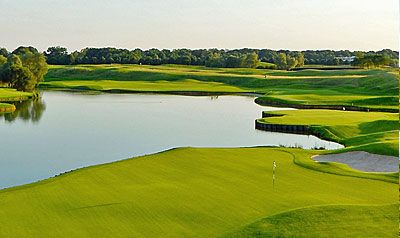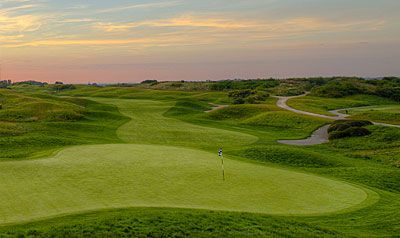- News
- Behind the architectural curtain - 42nd Ryder Cup - Le Golf National
Behind the architectural curtain - 42nd Ryder Cup - Le Golf National

42nd Ryder Cup Matches - Le Golf National
Behind the architectural curtain
Interview with M. James Ward
For many people the hosting of the Ryder Cup Matches at Le Golf National will be a major eye-opener. Although the course has hosted numerous French Opens, it has not served as host for an event of the magnitude that will happen this week.
The 18-hole L'Albatros course provides for a healthy mixture of challenges -- most notably off the tee. The pressure of the matches will only intensify as each progresses throughout the round. The ending quartet of holes is most demanding with water lurking always nearby.
To get a better assessment specifically of the golf at Le Golf National and France generally, I reached out to the President of the European Institute of Golf Course Architects for his assessment.
Ross McMurray

President of the European Institute of Golf Course Architects and a designer with European Golf Design, based in Sunningdale, Berkshire. A graduate in Landscape Design, McMurray began his career in the golf course architectural practice of Cotton, Pennink and Partners in 1988. The company became European Golf Design in 1992. Ross was responsible for the Twenty Ten Course at Celtic Manor Resort, Wales, which hosted the 2010 Ryder Cup, and was lead designer on the Marquess Course at Woburn Golf & Country Club. He has most recently completed new courses at Mill Creek near St Petersburg and for Royal Norwich Golf Club at their new home outside the city. Ross collaborated on the updates to Le Golf National in preparation for the 2018 Ryder Cup matches.
For only the second time the Ryder Cup Matches will be played on the Continent of Europe. Was the selection of Le Golf National and France a smart move overall?
McMurray: I think it has been a wonderful decision which I’m sure will pay dividends in driving forward interest in the sport in Europe. The enthusiasm shown for both teams during practice this week has been outstanding and it is already clear to me that the event will be a huge success. This is a great opportunity for the European golf bodies to build on the exposure the sport will get through the Ryder Cup.

What are the key strengths of the design?
McMurray: The Albatross Course is a fantastic golf course which really challenges the player, especially off the tee. It will depend on the weather conditions, but I suspect that we won’t see too many drivers being used. The course rewards accurate shot placement and it will be vital to keep the ball on the fairway. I’m sure the rough will be quite penal so the players will want to stay on the short mown grass as much as possible. Le Golf National is one of the most popular venues on the European Tour and the Ryder Cup presents a great opportunity for the rest of the world to see why that is. The sequence of holes from 15 to 18 will certainly be memorable for everybody watching.
Any discernible weakness?
McMurray: Not really, perhaps there are one or two slightly blind shots which might not be everyone’s cup of tea, but generally the course is significant because of its lack of weaknesses. The course needed very little tweaking for the Ryder Cup. We rebuilt two greens to provide some additional pin positions and adjusted some bunkering, but much of our work involved making improvements on and around the course for infrastructure and spectators.
How would you set-up the course for the event? For example, narrowing the fairways considerably -- slowing down the greens?
McMurray: I think that the important thing is to set up a golf course that is generally quite fair for both sides. There will undoubtedly be certain differences in how a golf course might be set up in Europe compared with the USA. Green speeds might be a little slower for example, to more closely match what most of the Europeans are used to, but I suspect that it is possible to get too cute trying to set up a course that will suit particular players. You have to remember that the presentation of the golf course is determined months before the selection of the teams, so to try and second guess what sort of course will suit certain players before you know the personnel who will be involved is quite risky and could backfire. The fairways at Le Golf National are never particularly wide and I don’t see that changing for this week.

What's your assessment on why Robert von Hagge's contributions to the design have been understated?
The course was designed nearly thirty years ago and I’ve got no idea what was agreed or who did precisely what at that time. From what I’ve seen on various official websites all those who were involved are credited.
Many people globally may not be aware of the qualities of French golf. In your estimation -- how good is the overall golf when held against the best countries in the world such as USA, United Kingdom, Ireland, Canada, Australia and South Africa?
I think that golf in France is hugely underrated. A large number of the top 100 courses in Continental Europe are in France, including seven of the top twenty. In Paris alone, as well as Le Golf National, there is Morfontaine, Fontainebleau, Chantilly and Saint Germain, all classic golf courses with histories stretching back to the Golden Age of golf course architecture. They are wonderful courses which deserve greater recognition.
Curious to know -- the top three French courses to play are?
Any three of the above. You won’t be disappointed. Les Bordes is also very highly rated.
OK - time for predictions -- who wins and why?
It’s tough. The Europeans are so familiar with the golf course and that has to help. On the other hand the USA look incredibly strong. If the wind gets up I would favor a narrow European win, if the conditions are calm then I think I might just favor the American side. I’m sure it will be close, whatever happens.